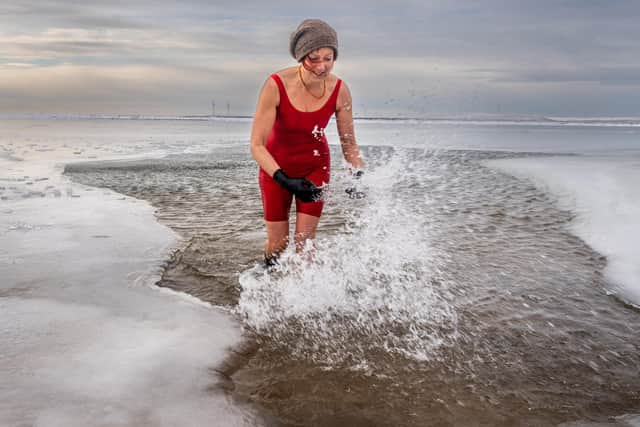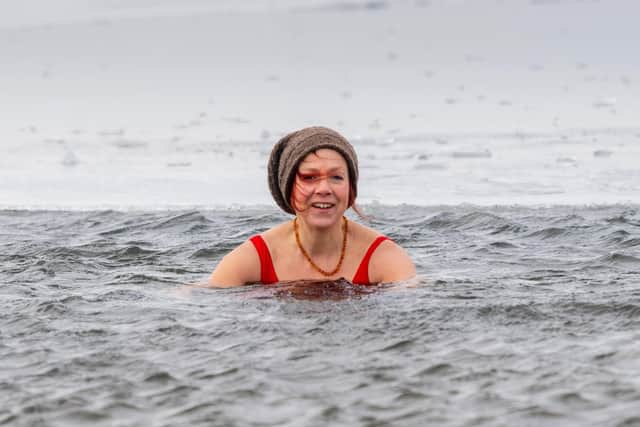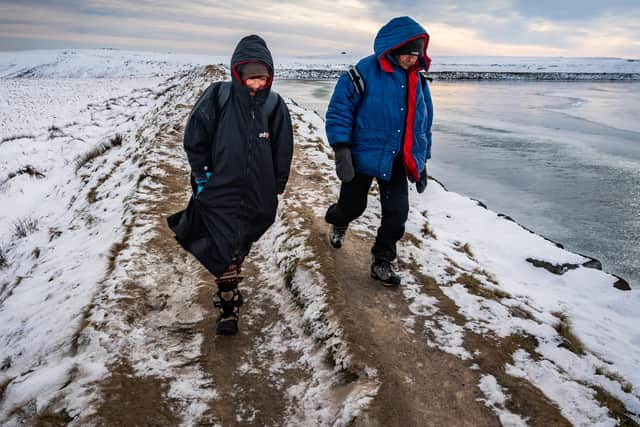Meet the Yorkshire women taking the plunge with open water swimming in depths of winter
The thought of plunging into icy water would leave most of us cold. But the sport of outdoor swimming in freezing temperatures is gaining popularity – particularly with middle-aged women – who take part for health benefits and also to raise money for charity.
Jamima Latimer and Sonya Moorhead, both from Todmorden, have been joined, remotely, by 28 ‘dippers’, as the swimmers call themselves, from Yorkshire, Cumbria and Lancashire, and are on track to raise £41,000 in aid of homelessness charity Crisis UK.
Advertisement
Hide AdAdvertisement
Hide AdWinter swimming typically takes place in outdoor locations or in unheated pools or lidos. This is the fourth year running that the team of hardy swimmers stepped into rivers every day in January, embarking on a month of swimming outdoors, wearing just swimming costumes and big smiles.


This year the challenge was named ‘Icebreaker’, as sheets of ice often have to be broken to allow entry into the water.
“A very large number of outdoor swimmers are middle-aged women,” says Sonya. “We’re a fairly invisible demographic in many ways but especially when you look at media coverage of the sports world.
“Swimming outdoors requires a level of mental control and physical endurance and that shouldn’t be underestimated. Quietly, through little friendship support bubbles, we’re seeing a massive increase in this army of mighty women across the whole country. They’re reclaiming the countryside in their own way and getting super healthy doing it.”
Breaking the ice has been par for the course this winter.


Advertisement
Hide AdAdvertisement
Hide Ad“Everyone’s been laughing at me recently because I have a rubbish toffee hammer in my swim bag, but some of my swim buddies have proper ice axes,” adds Sonya.
“One thing I’ve really enjoyed discovering is all the different types of ice and trying to work out what weather conditions have made them.”
Fellow swimmer Catherine Long says: “It makes you feel quite intrepid and there’s something magical about swimming in ice.
“The sounds of the ice tinkling – or clanking, depending on how thick it is – are brilliant and unlike anything else.


Advertisement
Hide AdAdvertisement
Hide Ad“Strangest is when it’s only just dipped below zero so there’s a really thin layer of ice, because when that happens it ripples as you swim, which looks really odd.”
Shipley swimmer and self-confessed ‘weirdo’ Ellie Clement says sometimes the ice can be 8 to 10 mm thick, and you have to snap bits off. “Catherine says it’s a bit like swimming in a gin and tonic, you bump into bits of ice while you’re swimming around.”
Ellie started swimming in the summer about three years ago.
“I really enjoyed being immersed in the water and seeing kingfishers, one of them barrel-rolled past me once, and it was amazing.
Advertisement
Hide AdAdvertisement
Hide Ad“Herons swooping, cormorants, so much – you just look at the world from a different perspective. It’s really beautiful, you’re encased in the world, you can’t do anything but experience it.
“At the moment we’re quite distant from people and the things we might ordinarily be doing.
“It’s about physically not having any option but to be in the moment, in the bit of time that you are in the water.”
In the winter in West Yorkshire, the water can be lower than 5C.
Advertisement
Hide AdAdvertisement
Hide AdThe women recall ‘dipping’ in water resembling Slush Puppy drinks at -0.5C.
Science suggests that cold water and the shock it induces in the body sends a boost which can lift your mood, ease anxiety, improve your immune system and even ward off dementia and symptoms of menopause.
“So if you’ve experienced any of that, it really does help hit a sort of chemical reset button,” says Sonya, who grew up by the sea in Northern Ireland.
“I’ve never not swum. My mum is a terrific, strong swimmer and still swims outdoors throughout the year, she’s 75. I just do it because it’s a moment for me to collect myself, away from my family and work and life commitments; I’m in nature, taking a bit of exercise and I feel most like myself when I’m in the water.
Advertisement
Hide AdAdvertisement
Hide Ad“Where I live, you have to walk for at least 20 minutes to get to a swim spot, so it puts me in the right frame of mind as I approach the water, nice and calm. I get in slowly, and make sure I know where I’m putting my feet – it’s important you know how you’re going to get out at the end, if there are any wobbly, slippery or steep areas.
“I like to go on my own for a bit of head space or with close friends who like to enjoy the sound of the water and birds and the wind.
“If you’re listening to your body, you just know when it’s time to get out. Sometimes you can push that a bit further and go for a longer swim and build up your tolerance of the cold. Other times it’s just a few minutes and you’re out.
“One of the big benefits for me is confidence. I sometimes think to myself - ‘Gosh look at me, like Scott of the Antarctic!’ If I can do these micro adventures, I can do anything. There are so many benefits – companionship, getting outdoors, feeling a real buzz.”
Advertisement
Hide AdAdvertisement
Hide AdCatherine, who swims in rivers and reservoirs near her home in and above the Calder Valley, experienced her first swim four years ago on a chilly January day in a local lake with a couple of friends.
“There was a lot of hesitancy from us all and a lot of squealing as we got in. The first couple of times it was literally just a dip – in, swim about for a few strokes, and out again.
“But the buzz afterwards, that lingers for a long time, is compulsive, so I haven’t looked back since then. These days, I don’t tend to squeal like I used to because I know it’ll be fine after the first few strokes.”
No special equipment is needed other than the swimsuit. Some wear neoprene gloves and shoes but most importantly is having enough layers of dry clothes to get into quickly once you get out.
Advertisement
Hide AdAdvertisement
Hide Ad“Hot drinks and snacks are also nice,” says Catherine, “although since Covid, we haven’t been able to share them around in the way we used to.”
Jamima has created an outdoor changing bag, called the Swim Feral Turtleback bag, which adds a level of comfort when changing on wet, muddy or icy ground. A flask of hot drink, even in the summer, is imperative to help reheat after a swim.
There’s no time to hesitate, she adds.
“I’m a plunger – I like to get straight in and swim. This time of year, I’ll swim for about 10 minutes – the water is cold, anywhere between one and five degrees.
“But it’s always a delight. Early in the morning you see the colours becoming more visible and your breath in clouds over the water.
Advertisement
Hide AdAdvertisement
Hide Ad“Then out again, get dressed as fast as possible – although sometimes cold fingers make for clumsy dressing. Then a brisk walk home, grinning, and a cup of tea to warm up.”
Advice for beginners
The group recommend that beginners to open water swimming make their first attempts in late spring or early summer to gradually build up their tolerance of the cold ahead of temperatures dropping when autumn arrives.
It is recommended that you don’t go on your own and join a group or find an outdoor swim guide.
Compared to indoor heated swimming pools, which vary in temperature from around 26 to 31C, swimmers are likely to be exposed to a much wider range of temperatures when swimming outside. In the UK, inland waters can be as low as zero in winter to as high as the mid 20s in the summer.
Advertisement
Hide AdAdvertisement
Hide AdTo donate, visit www.crisis.org.uk/get-involved/fundraise/crisis-icebreaker
Support The Yorkshire Post and become a subscriber today. Your subscription will help us to continue to bring quality news to the people of Yorkshire. In return, you’ll see fewer ads on site, get free access to our app and receive exclusive members-only offers. Click here to subscribe.
Comment Guidelines
National World encourages reader discussion on our stories. User feedback, insights and back-and-forth exchanges add a rich layer of context to reporting. Please review our Community Guidelines before commenting.